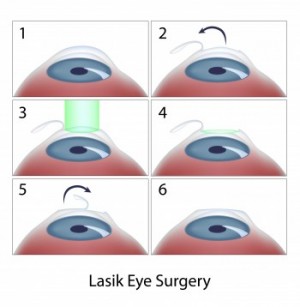LASIK Surgery – An Introduction
Medically Reviewed by: Dr. William Ellis

On this page: Is LASIK right for you? | Procedure | Risks & complications | Cost | Choosing a surgeon – En Español
LASIK is a type of laser eye surgery that improves vision by removing corneal tissue with an excimer laser to reshape the eye’s cornea, the thin outer covering of the eye. It can address different types of refractive errors, including myopia (nearsightedness), hyperopia (farsightedness) and/or astigmatism.
LASIK cannot address the root cause of presbyopia (age-related farsightedness), but another type of LASIK procedure — monovision LASIK— can treat the condition and reduce your need for reading glasses or bifocals.
There are several different types of LASIK, including traditional LASIK, wavefront-guided LASIK (custom LASIK) and EPI LASIK (blade free). Traditional LASIK uses a similar laser profile for all patients, while wavefront LASIK uses a customized laser profile for each eye. EPI LASIK is a totally blade-free procedure and can be used with either traditional or wavefront LASIK. These specific variations of LASIK are discussed in more detail below.
The following video offers a general introduction to LASIK surgery. Continue reading below for additional details on your candidacy for treatment, preparing for treatment, measurements before surgery, procedure steps, its risks cost, and guidelines for finding the right surgeon for you.
Is LASIK Right for You?
Hundreds of thousands of people seeking 20/20 vision or better opt for LASIK surgery each year. However this popular corrective procedure is not for everyone.
Most LASIK patients fall between the ages of 20 and 55. It’s not recommended for people under the age of 18 because the eyes are typically still developing.
If you are pregnant or nursing, the associated hormone imbalance can cause unstable vision, making you ineligible for LASIK. Similarly, if you’ve recently had a change in your contact lens or eyeglass prescription, your vision may be considered too unstable for LASIK in the short term.
If you have dry eyes you may not be a good candidates for LASIK as the treatment could worsen the condition. However, dry eyes can be treated using drops and LIPIFLOW Similarly, if you suffer from any number of other underlying eye conditions (cataracts, glaucoma, keratoconus, etc.) your candidacy may be affected.
(To get a better understanding of your candidacy, check out our “Are You a Candidate for LASIK” slideshow.)
Measurements During LASIK Consultation
During the consultation, the eye doctor or staff will take a number of measurements to determine your candidacy and the level of vision correction you may need. For wavefront LASIK, your surgeon will measure the curvature of your cornea using wavefront mapping technology. This allows the laser to create a customized profile for each of your eyes based on minute variations in the shape of the cornea.
Your surgeon will also measure the thickness of your cornea to ensure it is thick enough to have LASIK. This is done with a device called a pachymeter, which omits sound waves to measure the cornea’s thickness. Measuring corneal thickness is an important step in determining candidacy for LASIK because the excimer laser removes part of the cornea during the procedure. One of the most common reasons patients do not qualify for LASIK is that their corneas are too thin; i.e. the corneas do not have enough tissue to be reshaped with the laser.
Most surgeons will also measure your tear break up time to determine whether or not you have dry eye. The level of dry eye can affect your candidacy, as described above, but can be treated enough to allow for subsequent LASIK.
Preparing for Surgery
Your surgeon will help prepare you for LASIK during your pre-treatment consultation. This preparation includes, in addition to the measurements described above, things like making sure you’ve got a ride home after the procedure and discontinuing the use of contact lenses prior to treatment. Lenses can alter the shape of the cornea and interfere with the measurements required for a successful outcome.
For those who wear rigid gas permeable (RGP) contact lenses, you may need to stop wearing them four weeks (or longer) before LASIK. Soft contact lens wearers most likely need to discontinue use typically for one week before surgery. This change can be an inconvenience, but most patients have no problem wearing eyeglasses during this period.
The night before your surgery, it’s important that you clean away any makeup residue from around the eyes. Similarly, you will be asked to avoid wearing makeup, facial moisturizers or even perfume/cologne the day of treatment.
If you take daily medications, speak with your surgeon about whether or not you should avoid taking any of these drugs prior to surgery. (In most cases, you should be able to take your medications without issue.)
The Procedure
The first step in the LASIK surgery procedure is for your surgeon to administer anesthetic drops to numb the eye. The drops diminish corneal sensitivity, and in doing so, typically make the procedure pain-free.
Next, the surgeon creates a thin flap in the cornea using either a microkeratome (surgical blade). A small piece of the flap remains attached to the cornea. The flap is then peeled back to expose the underlying corneal tissues.
Once the corneal flap has been made, the surgeon changes the shape of the cornea using a type of laser called an excimer laser. The laser reshapes the cornea with pulses of ultraviolet light that ablate (vaporize) small amounts of corneal tissue. This, in turn, allows the eye to focus light more accurately. Correcting the shape of the cornea usually takes less than a minute, after which the corneal flap is gently put back into place. The flap seals on its own and acts as a bandage. No stitches are required.
Your surgeon may prescribe eye drops to decrease the risk of infection and reduce swelling.

Risks and Possible Complications
Within a few days Standard Lasik, most patients experience excellent vision without the need for glasses or contact lenses. For several weeks after surgery, it is normal to experience some fluctuations in vision, as well as other symptoms. All surgeries have some level of risk, including LASIK. Possible complications of LASIK include:
-
-
- Vision fluctuations
- Blurry vision
- Glare
- Halos around lights
- Dry eye
- Diminished quality of vision
-
-
-
- Infection
- Overcorrection
- Undercorrection
-
LASIK Cost
According to survey data, the average price for LASIK in the U.S. varies from $2,000 to $ 2,500 per eye.
However, the price can differ markedly from practice to practice due to a number of factors, including the level of correction, the instruments used and the surgeon’s experience.
One word to the wise regarding the cost of LASIK: Be skeptical about “discount” offers. These offers often exclude the cost of preoperative and follow-up appointments, postoperative medications and other services and aspects of the process.
Custom LASIK – Benefits, Pricing and Candidacy
If you’re looking for a more precise and personalized LASIK option then custom LASIK (also called wavefront LASIK) might be the best choice for you.
Some of the more noteworthy benefits of custom LASIK include:
Enhanced vision – Custom LASIK doesn’t just correct common visual problems such as nearsightedness, farsightedness and astigmatism; it also corrects smaller, more obscure vision problems. As a result you have a better chance of achieving 20/20 vision or better following surgery — without corrective eyewear. Some patients see better following custom LASIK than they would have with glasses or contacts.
Reasonably Priced – Due to the advanced technology and additional equipment used in custom LASIK, the procedure will cost you more than traditional LASIK — at least a few hundred dollars more per eye. The price tag is usually about $2,250 or more per eye. If this is too much for you to cover in one payment, don’t fret — you have numerous financing options at your disposal.
Reduced Risk of Certain Complications – Compared to traditional LASIK, custom LASIK patients have a reduced risk of night vision problems, such as glare and halos around lights.
Other benefits of custom LASIK include a quick procedure time (around 15 minutes) and recovery, little to no discomfort and the ability (usually) to rid yourself of glasses and contact lenses.
To have custom LASIK, you should be at least 21 years old. It is also very important that you have realistic expectations, and that you fully understand the potential risks and complications. Your surgeon will conduct tests to determine if your corneas are thick enough for the procedure.
EPI LASIK – A Bladeless Alternative
As the name implies, EPI LASIK differs from traditional LASIK in that no blades is used. Instead, the epithelium on the surface of the cornea is lifted with a spatula after treatment with medication. You’re less likely to have complications with EPI LASIK, and your vision is likely to be better than with traditional LASIK.
Benefits you can expect from EPI LASIK include:
Amazing results – EPI LASIK can heal with sharper vision without creating a flap. A quick procedure – The entire process takes around 15 minutes.
Comfort – Most likely, you will experience minimal discomfort or pain intially.
Quick recovery time – Standard LASIK usually allows you to get back to work the next day.
Affordability – Prices vary, but in general you should expect to pay $2,250 or more per eye for wavefront-guided EPI LASIK.
Standard LASIK is a very safe procedure, and if you do have complications they are likely to be temporary. That being said, all surgical procedures have risks. Possible risks of LASIK include infection, fluctuating and/or blurred vision, glare and/or halos around lights, reduced quality of vision, overcorrection and under correction.
Some side effects of LASIK can be addressed down the road through touch-up surgery. If you have questions about this, ask your refractive surgeon for additional information.
Choosing the Right Surgeon for LASIK
LASIK is an extremely safe and effective procedure, but it’s still important to make sure you’re in the hands of the right surgeon. Although a lot of the selection process boils down to who makes you feel most comfortable, there are certain absolutes to keep in mind when selecting your LASIK surgeon.
Experience: There’s no substitute for experience. Many top LASIK surgeons have thousands of successful surgeries on their resume. It is important to ask how much experience does the surgeon you’re considering have.
Reputation: Surgical experience is important, but so too is patient experience. Reviews are as important as any other factor these days when it comes to making the “buy” decision. Check out what past patients have to say about their LASIK experiences with the surgeons you are considering.
Board Certification: Surgeons certified by the American Board of Ophthalmology typically boast a higher level of expertise. Ask if the surgeon is board certified.
FACS: Board-certified surgeons can have an additional “FACS” distinction, meaning they are a fellow of the American College of Surgeons. This fellowship holds its members to a higher standard of practice. Ask if the surgeon you’re considering holds a FACS designation.
Satisfaction Guaranteed: LASIK is a very safe and successful procedure, but not every procedure goes without a hitch. Revisions can and will be necessary on a case-by-case basis.
Fortunately, many surgeons offer a satisfaction guarantee that covers revision procedure free of charge. Ask if the surgeon you’re considering is confident enough to offer such a guarantee.
At the end of the day, these are merely helpful guidelines that can be used to narrow down your LASIK surgeon search. Don’t be shy about setting up multiple consultations so that you can meet the surgeons and staff, and evaluate the practice first hand.
Schedule an Appointment
Take the first step towards improved vision by scheduling an appointment with a top LASIK surgeon in your area today. Consultations are typically free and there is no commitment required. Even if you aren’t a candidate for LASIK, you can discuss alternative treatment options like PRK or EPI LASIK.
[Updated Jan 10, 2023]
About the Reviewer
William Ellis, MD, FACS, is a board-certified ophthalmologist and one of the first surgeons in the United States to perform LASIK eye surgery. He is the pioneer of Epi-LASIK surgery — an advanced form of laser eye surgery that requires an extremely thin epithelial flap. Dr. Ellis has been practicing ophthalmology for more than 33 years, and he has performed more than 68,000 laser eye surgery procedures.
He is the author of several ophthalmology textbooks and many scientific articles. Due to his extensive experience and numerous accomplishments, he was invited to chair a panel on the surgical correction of astigmatism at the 26th International Congress of Ophthalmology.




